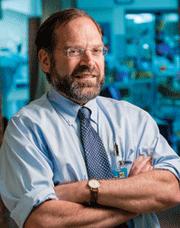
Dr. John Lantos, director of the Children’s Mercy Bioethics Center, deals daily with literal life-and-death questions — yet he says “there is no more important issue” than the one that will be argued and decided at The Ruth Fredman Cernea Great Latke Hamantash Debate, sponsored by Congregation Ohev Sholom, which takes place at 11:30 a.m. Sunday, Dec. 11, in the White Theatre at the Jewish Community Campus.
The relative moral standing of these two Jewish staples, the crisp potato pancake versus the lightly sweet, stuffed cookie, has intrigued Lantos for more than two decades, ever since he first took the stage at the University of Chicago, where the Great Latke Hamantash Debate has raged since 1946. His pro-latke thesis from that showdown, “The Bioethical Implications of the Latke-Hamantash Debate; or, Small Fry, Deep Fry, in Your Eye, Northrop Frye,” is featured in “The Great Latke Hamantash Debate” (University of Chicago Press, 2006), edited by Cernea, in whose memory her niece Melanie Allmayer established the annual Kansas City event in 2013. Here, for the first time in 23 years, Lantos will return to the debate podium — only now to take up the cause for Team Hamantash.
Corresponding from India, where he had traveled to teach a course in bioethics, Dr. Lantos took a moment to reflect on his experience in the Chicago Debate, his family’s transition to Kansas City — and his commitment to settling this critical issue once and for all on December 11.
How did you come to be involved in the Great Debate at the University of Chicago, and what was the experience like?
Lantos: By the time I joined the faculty in 1987, [the Debate] was well-established. It was recognized by students and faculty alike as a unique, uniquely funny event. Very distinguished faculty, including many Nobel Prize winners, participated. What made it so wonderful was that these serious intellectuals took humor very seriously — as all good comedians do — and they worked very hard to frame an absurd argument in the language of their academic discourse. I was invited [in 1993] when I was just a junior faculty member, and it was a great honor to be invited to participate.
The debaters wore full academic regalia — elaborate robes and hats — and were introduced with great fanfare, including heralding trumpets and drums. The auditorium was packed and ready to laugh, cheer, and boo.
Can you share a bit about your life in Chicago and the work that eventually brought you to Children’s Mercy and Kansas City?
Lantos: Before moving to Kansas City, I lived in Chicago and was on the faculty of the University of Chicago for 20 wonderful years. We raised three daughters there, and were active members of Kam Isaiah Israel Congregation when Rabbi Arnold Jacob Wolf was there and when Max Janowski was the music director — Max is the man who wrote the melody for Avinu Malkenu that was made famous when Barbra Streisand covered it, and that we use at Beth Torah today.
In Chicago, I studied and taught pediatrics and bioethics. I always dreamed of creating a bioethics center in a children’s hospital. I was thrilled when Children’s Mercy’s leadership decided to become national leaders in this area and created a program [in 2009] that was just the second of its kind in the country. It’s been great to be at Children’s Mercy and to have found Congregation Beth Torah as a spiritual home here. My wife, Martha Montello, grew up in K.C. That made the transition easier. It’s been great for both of us to be here.
How do you feel about the opportunity to take part again in a Great Debate — albeit switching from latke to hamantash?
Lantos: Well, one of the wonderful things about growing older is that, occasionally, we also become a little wiser. That is difficult, too, because one realizes the stupid mistakes that one made as a youth. Today, now that I am a grandfather and have plenty of gray hair, I realize that my allegiance to the latke was a disgraceful, youthful indiscretion. Understandable, perhaps, because the shallowly attractive, oil-glistening latke is just the sort of food that would appeal to a callow youth. Now, though, I welcome the opportunity to teach others what I have learned of the subtle joys, the sophisticated pleasures, and the astounding diversity of tastes that one can enjoy once one comes to fully appreciate the humble hamantash.
Why do you think this is a special event that should appeal to anyone in the community?
Lantos: There is no more important issue facing the Jewish community in Kansas City, in the U.S., and throughout the world than the issue that is at the heart of this debate. There is, after all, not a Latke America and a Hamantash America. There is just the United States of America. In a land that is increasingly ethnically diverse, we need to learn to see and understand “The Other.” This debate embodies the best in us — respectful disagreement about overwhelmingly important issues. Most importantly, it is an opportunity to laugh together and laugh at ourselves. Everyone should attend because we are stronger together.



